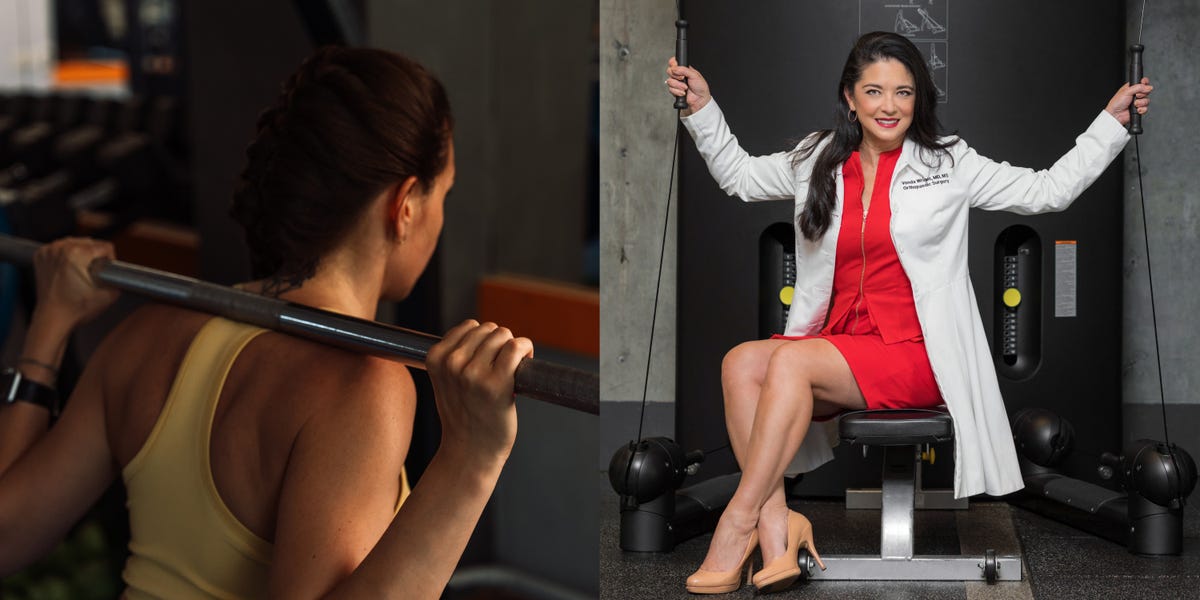- Taking good care of our musculoskeletal health can help us stay strong and active as we age.
- Dr. Vonda Wright is an orthopedic surgeon specialized in healthy aging.
- She lifts heavy weights and does jump training every week to age well.
A muscle and bone doctor who specializes in healthy aging shared her weekly exercise routine, which helps her maintain strength and mobility as she ages.
Dr. Vonda Wright, 57, is a Florida-based, dual-certified orthopedic surgeon who helps elite athletes, including Olympians and World Rugby Sevens players, optimize their performance.
In our 30s and 40s, we begin to naturally lose muscle mass, which is crucial for continuing to perform everyday movements such as getting up from a chair. The process begins between the ages of 65 and 80.
It’s important to stay active to prevent our bones and muscles from weakening, and those who lead sedentary lives eventually lose strength and balance and begin to fall over or shuffle when they walk, Wright told Business Insider.
About 12% of American adults over age 50 have osteoporosis, and 43% have low bone mass, a precursor to osteoporosis, according to the National Center for Health Statistics. But practice significantly reduces the risk, Wright said
“Musculoskeletal aging and healthy aging is a lifelong pursuit,” she said. “Just show up for yourself every day.”
The “critical decade” when people start developing habits that allow them to live healthy, active lives into old age is between ages 35 and 45, says Wright, the author of “Fitness After 40.”
“70 to 80% of how we age is due to lifestyle choices,” Wright said.
With that in mind, she works out five to six days a week, including cardio and strength training.
Powerlifting
Wright recommends everyone learn to lift weights to build and maintain muscle mass.
She is a fan of powerlifting, which consists of deadlifts, bench presses and squats. She does four sets of four reps each and makes sure to challenge herself with heavy weights.
“I can do four with good form. I’m exhausted. I can maybe do five, but I can’t do six. If I can, it’s too light and I have to go up,” she said.
She also does some additional lifts that target individual or smaller muscle groups, usually focusing on her biceps, triceps, lats and deltoids. She does four sets of eight reps.
Running according to the 80/20 rule
Wright usually does her cardio on a treadmill. Travel Couples/Getty Images
When it comes to aerobic exercise, Wright follows the 80/20 rule, which means she does low-intensity training, also called zone 2 training, 80% of the time and high-intensity training the remaining 20%.
Research shows that this approach increases endurance and improves cardiovascular health.
“For everyone from novice runners to elite athletes, longer runs while maintaining a low heart rate are really beneficial for building aerobic endurance,” says Dr. Morgan Busko, sports medicine physician at NewYork-Presbyterian/Columbia University. Irving Medical Center, previously against BI. “By running slower for longer periods of time, you prepare yourself to run faster.”
Wright typically runs on a treadmill for 45 minutes at about 60% of her maximum heart rate, and twice a week she finishes with some speed training. She sprints four times as fast as she can for 30 seconds.
“When you sprint like that and really push yourself, no matter your age, you feel like a bit of a badass,” she said.
Jumping exercise
To maintain bone density, everyone needs some jumping exercise, Wright said, especially if you sit at a desk all day. This could include jumping off a box, jumping rope or even running up the stairs, she said.
She does box jumps between the lifts twice a week and gets up from her desk and jumps up and down 20 times during the day. “My patients are used to seeing me jump around,” she said.
In a 2009 study published in the journal Sports Health: A Multidisciplinary Approach, Wright and her colleagues measured the bone density of 560 senior athletes with an average age of 65.9 years. They found that those who practiced high-impact sports such as volleyball, basketball and running had the highest bone density.
When a person has low bone density, the risk of fractures and fractures, as well as osteoporosis, increases.

